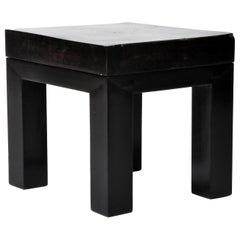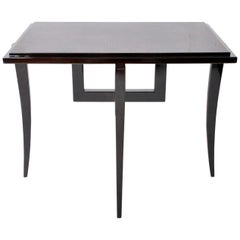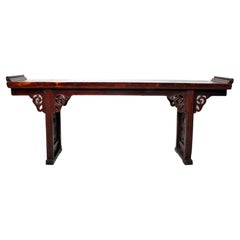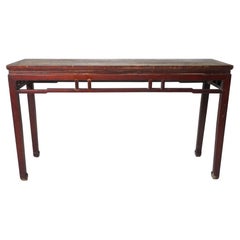Want more images or videos?
Request additional images or videos from the seller
1 of 6
French Café Table
$850List Price
About the Item
- Dimensions:Height: 28.5 in (72.39 cm)Width: 23 in (58.42 cm)Depth: 23 in (58.42 cm)
- Materials and Techniques:Metal
- Place of Origin:France
- Period:20th Century
- Date of Manufacture:circa 1960
- Condition:Wear consistent with age and use. Minor losses. Minor fading.
- Seller Location:Chicago, IL
- Reference Number:Seller: 18E030441stDibs: LU886413281072
About the Seller
4.9
Gold Seller
Premium sellers maintaining a 4.3+ rating and 24-hour response times
Established in 1989
1stDibs seller since 2010
440 sales on 1stDibs
Typical response time: 1 hour
Authenticity Guarantee
In the unlikely event there’s an issue with an item’s authenticity, contact us within 1 year for a full refund. DetailsMoney-Back Guarantee
If your item is not as described, is damaged in transit, or does not arrive, contact us within 7 days for a full refund. Details24-Hour Cancellation
You have a 24-hour grace period in which to reconsider your purchase, with no questions asked.Vetted Professional Sellers
Our world-class sellers must adhere to strict standards for service and quality, maintaining the integrity of our listings.Price-Match Guarantee
If you find that a seller listed the same item for a lower price elsewhere, we’ll match it.Trusted Global Delivery
Our best-in-class carrier network provides specialized shipping options worldwide, including custom delivery.You May Also Like
French Café Table
Located in Hellerup, DK
Charming antique French café table with an oak wood top on a cast iron base - the table is manufactured in Paris by Joubert around the 1900s.
Category
Antique Early 1900s French Tables
Materials
Iron
Vintage French Louis XV Style Painted Wicker Table
Located in Forney, TX
A substantial, heavy, 3/4" thick circular glass top with 1" beveled edge rests atop a French Louis XV style table, charming antiqued finish distressed painted green with partial gilt accents, having a highly decorative cane webbed rattan wicker decorated top forming concentric circles of unique patterns within a round serpentine shaped molded edge top, over a gently undulating scalloped apron, rising on faux bamboo cross-stretcher joined carved cabriole legs, terminating in whorl feet. Attributed to historic American retailers Barker Brothers Furniture...
Category
Late 20th Century Louis XV End Tables
Materials
Faux Bamboo, Wicker, Cane, Rattan, Glass, Paint
19th C. French Charles X Restoration Period Sewing Stand Work Table
Located in Forney, TX
A scarce period Charles X (1818-1834) French Restoration mahogany travailleuse sewing (thread stand - side table - jewelry dressing table) with light, warm, beautifully aged patina.
Born in France in the early 19th century, almost certainly Parisian work, exquisitely hand-crafted, this exceptionally executed example features ornate gilt bronze ormolu mounts, escutcheons, and elaborate gilt metal trim. Having a highly figured light mahogany hinged lid top, lifting open to reveal a striking finished interior with divided compartments and original inset mirror plate. The conforming rectangular case fitted with a faux drawer front over a dovetailed drawer with sectioned interior. Elegantly rising on oval-shaped medial shelf stretcher-joined curvacious legs.
Dimensions (approx):
27" High, 20" Wide, 13.5" Deep
Stunning light almost blonde antique mahogany coloring and mellow warm tone, superb wood grain detail, and charming, beautifully aged patina over the whole. Great shape overall. Retaining original antique character marks, wear consistent with age and indicative of minimal use, nothing that detracts from the aesthetics or functionality, but only adds to the overall authenticity, refined elegant warmth, luxurious sophistication, and cozy unpretentious rustic elegance.
Delivered cleaned, hand waxed, polished French patina finish, ready for immediate use and generational enjoyment!
What is Charles X style:
The comte d’Artois – or Charles X - was the son of the dauphin Louis-Ferdinand de Franc and Marie-Josèphe de Saxe. He succeeded his two brothers Louis XVI and Louis XVIII and became the King of France in 1824. Thirty years after the French Revolution, he wanted to embody the return of monarchy and became the leader of the catholic party . As the previous kings, he was crowned in 1825 but he was soon overthrown by the revolution in July, 1830, called "Trois Glorieuses". He left then for England, Scotland, Prague and Istria where he died in 1836.
Charles X style lasted from 1818 to 1834 and happened during the Bourbon Restoration (French Restoration). This style did not replace totally the style of furniture from the French Empire but it was different from the formalism in the Napoleonic era, during which strictness and simplicity were inspired by Greco-Roman art. Indeed, artistic fields flourished. In terms of furniture, this renewal was suggested by the softening of shapes. Even though the simple aspect from the French Empire was still visible, shapes became curvier with volutes and arabesques. Another distinction is the loss of the massive aspect of furniture and the decrease of dimensions in order to decorate smaller appartments. Handling ability and comfort were key-words in the making of furniture. Apartments had essential elements such as chests of drawers, big rounded tables in the dining room, desks or secretaries, armoires and even dressing tables, comfortable fainting couches in the living room, small tables, pedestal tables, as well as gondola chairs. The wavy aspect of the latters certainly represent Charles X style the best.
One of the most emblematic features of this style is the use of bois clairs – light woods in warm blond tones - and indigenous woods that are varnished in order to highlight the grains. Bird's-eye maple, ash trees, plane trees, yew trees, beech trees, olive trees and cedar trees were most likely to be used. Indeed, at the beginning of the 19th century dark woods were hard to find. In 1806, the Napoleon’s Continental System was established in order to ruin the United Kingdom by preventing the country from any business with the rest of Europe. Therefore craftsmen had to find alternatives from mahogany which was the most commonly used material at this time. After 1815, the import of wood was even more difficult because of peace treaties and the European political situation, which contributed to the popularity of the bois clairs and indigenous woods. The furniture was often decorated with fine inlays made out of dark wood representing foliage, which contrasted with the veneer. Even though these patterns can look like bronze decorations from the Empire era, they were far more simple and did not represent any military or mythological attributes. On the tables, trays were sometimes made out of marble as in the French Empire, but it was often put aside and inlaid veneer, Verre Eglomisé – a type of glass with a mirror finish –, mirror or porcelain from Sèvres or Paris were more likely to be used.
Decorative elements from the Monarchy were highly appreciated again as they suggested luxury. Indeed, marquetry work was particularly fashionable - Boulle marquetry thrived around 1820 as the works of the Levasseur family can show. In the same way, draperies and trimmings referred to the monarchist splendour. Fabrics were often white – the traditional colour of the Bourbons – or light coloured as oppposed to the typical green from the Napoleonic era.
One of the most symbolic figures from this period of time might be Jean-Jacques Werner (1791-1849), a cabinetmaker who worked for prestigious clients such as the Duchesse de Berry who was Charles’s step-daughter. His works can be seen at the Musée des Arts Décoratifs and at the Grand Trianon in the Palace of Versailles. The duchess’s appartments situated at the pavillon de Marsan and at the Palais de Saint Cloud illustrate Charles X style the best with furniture made out of bois clairs and ornamented with dark wood patterns or fine gold decorations.
Chales X style allows a transition between the sobriety of the Empire style and the abundant aspect of Louis-Philippe style. The gothic style started at this time through the "style à la cathédrale", inspired by religious architecture, which thrived from 1827 to 1830. Indeed, at the beginning of the 19th century, Romanticism put the spotlight on the Middle Ages. Cabinetmakers were not inspired by the medieval furniture but rather by architectural elements of churches and cathedrals. For instance the backs of chairs were decorated with arches shaped like rib and serration. In the same way, before Charles X abdicated, pieces of furniture were made out of dark woods – such as mahogany, which was used again in France – and were inlaid with light wood. Romanticism also influenced the layout of furniture in appartments to suggest movement through a mix of various styles, various shapes and various sizes, as opposed to the static aspect of Neoclassicism. The start of industrialisation and mechanisation also influenced this style as early technical developments led to the production of pieces of furniture in series.
Credit:
Marc Maison
Bibliography:
FANIEL Stéphane (Dir.), Le Dix-neuvième Siècle Français, Collection Connaissance des Arts, 1957, Hachette
SASSONE, Adriana Boidi, Furniture from Rococo to Art Deco, 2000, Evergreen
--
Extremely versatile:
As warm and attractive as it is useful, this remarkable antique table having the ideal size and small proportions for a variety of different uses, including as a side table, accent or occasional table, tall sofa...
Category
Antique Early 19th Century French Charles X End Tables
Materials
Bronze, Ormolu
19th Century French Bouillotte Table with Breche D'alep Marble Top
Located in West Palm Beach, FL
Bouillotte occasional table, having a round top of Breche D'alep marble, surrounded by a pierced gallery of brass, on mahogany table base, with dou...
Category
Antique Late 19th Century French Louis XVI End Tables
French Louis XV Style Brass Ormolu Mahogany 2-Tier 3-Drawer Oval Side Table
Located in Germantown, MD
French Louis XV Style Ormolu Mounted Mahogany 2-tier 3-drawer side table in very good vintage condition. Features 3 drawers opening and closing very smoothly. Bottom shelf for additional display space. Ormolu mounted feet. Measures 17.25 inches in width, 12.75 inches in depth and stands 32.5 inches tall...
Category
Mid-20th Century American Louis XV Tables
Materials
Bronze
$1,650
H 32.5 in W 17.25 in D 12.75 in
French Cafe Tables, circa 1960s
Located in Isle Sur La Sorgue, Vaucluse
Nicely designed, rather small, square tables, with painted plywood tops, raised on splayed and tapered black metal legs.
8 available.
Category
Mid-20th Century French Mid-Century Modern Gueridon
Materials
Iron
18th Century French Painted and Gilded Carrera Marble Top Table, Circa 1760.
Located in Dallas, TX
18th Century French Period Painted and Gilded Carrera Marble Top Table. The elegant details on this Louis XV style French table have been highlighted by the hand-applied antique gild...
Category
Antique 1760s French Louis XV Tables
Materials
Marble
$3,250
H 26 in W 32 in D 27.5 in
Sculptural Bone Marquetry Table, Tabla Table
By Karl Springer
Located in New York City, NY
Step closer and let the beat of the Tabla Table resonate through every crafted curve and angle of this exquisite end table. Drawing inspiration from the timeless rhythm of this famed Indian percussion instrument, the Tabla End Table harmoniously merges cultural reverence with ultramodern aesthetics.
Its wood foundation, the unique form sets the stage for what can only be described as a symphony in wood and bone. The angular bone chips, meticulously arranged atop this base, sing a silent visual sonnet with their tonal pattern as a soundscape.
The tables sculptural essence is more than mere form; it's a dance. A quiet sway in spaces that transforms static interiors into dynamic stages where light and shadow pirouette across its rhythmic surface.
Honored with the illustrious NY Cottages & Garden Innovation in Design Award (IDA), it stands as a testament to design and craftsmanship.
But the Tabla's Resonance isn't just about grand accolades or its stunning aesthetics. Its also adaptable. Custom sizes mould it to your space's unique demands. And with an array of exquisite materials—from the deep allure of horn to the shimmering touch of Penn shell...
Category
21st Century and Contemporary Tables
Materials
Bone
Sculptural Bone Marquetry Table, Tabla Table
By Karl Springer
Located in New York City, NY
Step closer and let the beat of the Tabla Table resonate through every crafted curve and angle of this exquisite end table. Drawing inspiration from the timeless rhythm of this famed Indian percussion instrument, the Tabla End Table harmoniously merges cultural reverence with ultramodern aesthetics.
Its wood foundation, the unique form sets the stage for what can only be described as a symphony in wood and bone. The angular bone chips, meticulously arranged atop this base, sing a silent visual sonnet with their tonal pattern as a soundscape.
The tables sculptural essence is more than mere form; it's a dance. A quiet sway in spaces that transforms static interiors into dynamic stages where light and shadow pirouette across its rhythmic surface.
Honored with the illustrious NY Cottages & Garden Innovation in Design Award (IDA), it stands as a testament to design and craftsmanship.
But the Tabla's Resonance isn't just about grand accolades or its stunning aesthetics. Its also adaptable. Custom sizes mould it to your space's unique demands. And with an array of exquisite materials—from the deep allure of horn to the shimmering touch of Penn shell...
Category
21st Century and Contemporary Tables
Materials
Bone
Sculptural Bone Marquetry Table, Tabla Table, Instock
By Karl Springer
Located in New York City, NY
Step closer and let the beat of the Tabla Table resonate through every crafted curve and angle of this exquisite end table. Drawing inspiration from the timeless rhythm of this famed Indian percussion instrument, the Tabla End Table harmoniously merges cultural reverence with ultramodern aesthetics.
Its wood foundation, the unique form sets the stage for what can only be described as a symphony in wood and bone. The angular bone chips, meticulously arranged atop this base, sing a silent visual sonnet with their tonal pattern as a soundscape.
The tables sculptural essence is more than mere form; it's a dance. A quiet sway in spaces that transforms static interiors into dynamic stages where light and shadow pirouette across its rhythmic surface.
Honored with the illustrious NY Cottages & Garden Innovation in Design Award (IDA), it stands as a testament to design and craftsmanship.
But the Tabla's Resonance isn't just about grand accolades or its stunning aesthetics. Its also adaptable. Custom sizes mould it to your space's unique demands. And with an array of exquisite materials—from the deep allure of horn to the shimmering touch of Penn shell...
Category
21st Century and Contemporary Tables
Materials
Bone
More From This Seller
View AllTerracotta-Topped Table
Located in Chicago, IL
This small table or stool features a new wooden base mated to an old terra cotta tile top. The traditional floors of Chinese mansions were made from terracotta tiles laid in a grid. ...
Category
21st Century and Contemporary Chinese End Tables
Materials
Terracotta, Wood
$1,140 Sale Price
70% Off
End Table with Walnut Burl Veneer
Located in Chicago, IL
A fine Hungarian side table in the French Art Deco style. The book-matched wood grain is Hungarian walnut.
Though French Art Deco is much more famous...
Category
21st Century and Contemporary Hungarian Art Deco End Tables
Materials
Walnut
19th Century Chinese Altar Table
Located in Chicago, IL
This long, elegant altar table once provided a place to burn incense or display valuable art objects. It may have been used in the reception hall of a private mansion or in an ancestral shrine...
Category
Antique Mid-19th Century Chinese Console Tables
Materials
Elm
$5,800 Sale Price
39% Off
20th Century Chinese Wine Table
Located in Chicago, IL
This slim and elegant table was once used to serve wine during festival days and to display objects of beauty and value. It has a floating panel top, a narrow waist and graceful Tang...
Category
Early 20th Century Chinese Sofa Tables
Materials
Walnut
$3,800 Sale Price
41% Off
Vintage Chrome Coffee Table with Glass Top
Located in Chicago, IL
A brass-plated glass coffee table from the 1970s. During the interwar years Budapest was a hotspot of Art Deco furniture design and manufacturing. The Hungarian style was somewhat si...
Category
Late 20th Century Hungarian Coffee and Cocktail Tables
Materials
Chrome
$3,600 Sale Price
59% Off
Round Side Table with Book-matched Walnut Veneer Top
Located in Chicago, IL
This strikingly angular table has solid hardwood legs holding up a round top with pie-shaped, book-matched walnut veneers.
Category
21st Century and Contemporary Hungarian Side Tables
Materials
Walnut
$4,350 Sale Price
25% Off



